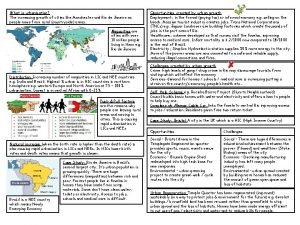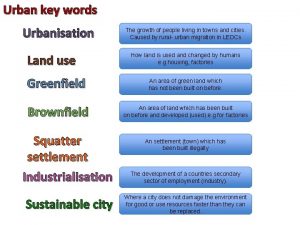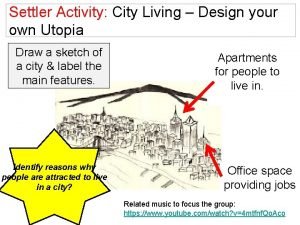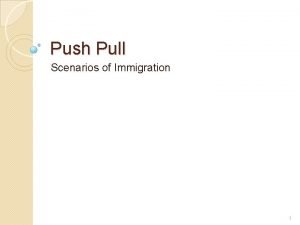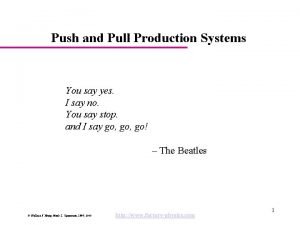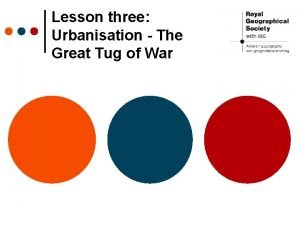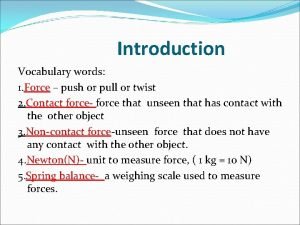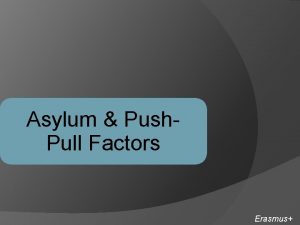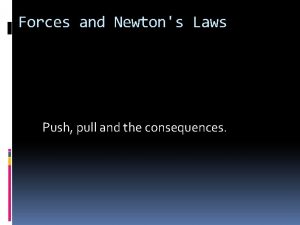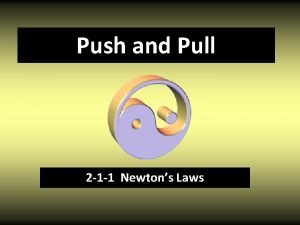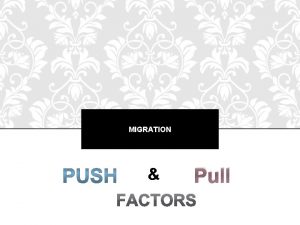Push and Pull Newtons Laws Newtons First Law











- Slides: 11

Push and Pull Newton’s Laws

Newton’s First Law An object at rest remains at rest, and an object in motion continues in motion with constant velocity (that is, constant speed in a straight line) unless it experiences a net external force. Also known as the “Law of Inertia” Inertia Tendency of an object to maintain its STATE OF MOTION Proportional to MASS

Do these guys have a lot of inertia? MORE MASS means MORE INERTIA LOTS OF INERTIA hard to… GET MOVING or STOP

Force • A push or pull on an object • May change the object’s STATE OF MOTION • CONTACT FORCE – requires touching – Normal, Tension, Friction • FIELD FORCE – no contact required – “Action over a distance” – Gravity (Weight)

A block of wood is sitting motionless on a table. What forces are acting on it? Normal Weight FN Fg Normal Force is a REACTION force that any object exerts when pushed on Weight is the force of gravity pulling an object toward the CENTER OF THE EARTH

Net Force • If there is no NET FORCE on an object it is at equilibrium and either: MOTIONLESS OR MOVING WITH CONSTANT VELOCITY • So a “net” or “unbalanced” force will – CHANGE AN OBJECT’S SPEED • Changing speed means ACCELERATION

Force Acceleration • How much acceleration? • Depends on: – AMOUNT OF FORCE • MORE FORCE = MORE ACCELERATION – MASS OF OBJECT • MORE MASS = LESS ACCELERATION

Newton’s Second Law “The acceleration of an object is directly proportional to the net external force acting on the object and inversely proportional to the mass of the object. ” Unit of force is the NEWTON (N)

Example • A 2 kilogram box is pushed with a net, unbalanced force of 10 newtons. • What is the acceleration experienced by the box? a = Fnet / m a = (10 N)/(2 kg) a = 5 m/s 2

Newton’s Third Law “For every action, there is an equal and opposite reaction” FN FT Fg Fg

Third Law Examples • A firefighter directs a stream of water from a hose to the east. In what direction is the force on the hose? There will be a force on the hose to the WEST • A man getting out of a rowboat jumps north onto the dock. What happens to the boat? The boat will move to the SOUTH
 Newton's first law and second law and third law
Newton's first law and second law and third law Si unit of newton's first law
Si unit of newton's first law Push and pull factors of urbanisation
Push and pull factors of urbanisation Push and pull factors of urbanisation
Push and pull factors of urbanisation Centripetal movement geography
Centripetal movement geography Curitiba sustainable city
Curitiba sustainable city Your
Your Push and pull scenarios
Push and pull scenarios Push and pull system examples
Push and pull system examples Push pull profile strategies marketing communications
Push pull profile strategies marketing communications Push and pull factors of urbanisation
Push and pull factors of urbanisation Push and pull vocabulary
Push and pull vocabulary



